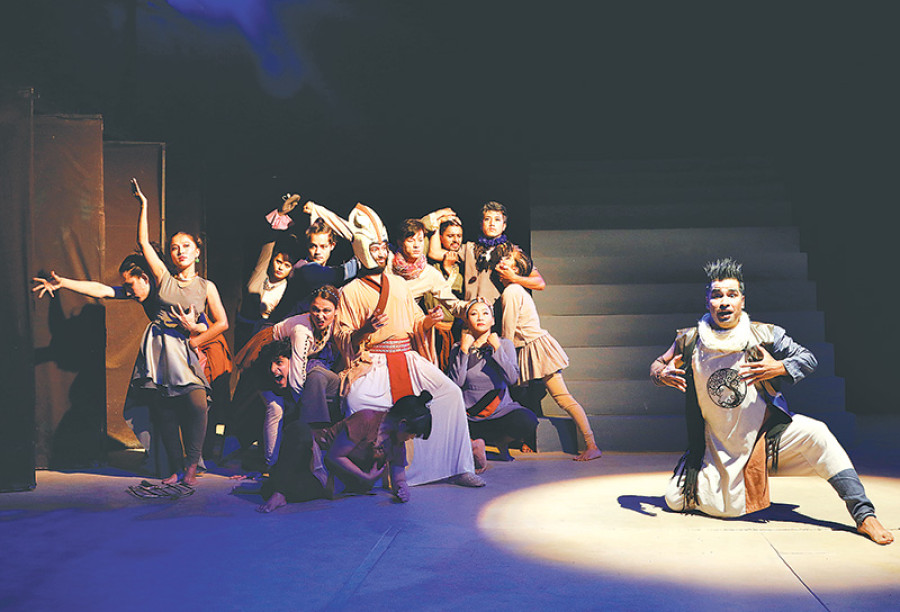Miscellaneous
Lost in translation
Consider these lines excerpted from the epic poem The Conference of Birds, written by the twelfth century Persian poet Farid ud-Din Attar:
Timothy Aryal
Consider these lines excerpted from the epic poem The Conference of Birds, written by the twelfth century Persian poet Farid ud-Din Attar:
The ocean can be yours;
why should you stop
Beguiled by dreams of
evanescent dew?
The secrets of the sun
are yours,
but you
Content yourself with motes trapped in beams…
The episode comes early on in the poem, announcing its premise: that passions are fleeting like “evanescent dew”, and that truth lies not running after carnal pleasures but in knowing yourself.
Like all great works of art, it prompts us to tackle questions of existence head on, leading us to a sudden spiritual transformation.
The poem was adapted for stage, by authors Peter Brook and Jean-Claude Carrière and a Nepali translation of the play is currently on stage at Shilpee Theatre in Battisputali.
Adapting a play for a drama comes with its own limitations; it is often very difficult to translate the feelings the imagery elicits onto stage.
But it is natural to suppose that the core idea of the original text is rendered well through the poetry of the visual medium.
Both the medium of arts—poetry and theatre—have their own merits and limits; if one passes the idea through words in poetry, one does so through theatrics on stage; nonetheless, both aim to take the audience through a certain spiritual quest.
The play The Conference of Birds—Charaharu ko Sammelan in Nepali (translated by Pushpa Raj Acharya; and directed by Deeya Maskey)—is itself based on the overarching theme of spirituality, of how a horde of birds go through a gradual transformation to realise the ultimate truth of existence.

The plot is simple: Faapre, the king of the birds, is out to persuade his fellow subjects to go out on a search for the mysterious, almighty king Simorgh, who lives seven mountains away.
It’s not that easy for Faapre to convince the birds, for all of them are busy in their own world, chasing after their own disparate passions—the kaalij says he loves the mountains and is content living on it; the pigeon says she loves the rose and is content living by it, and so on.
To convince them to set out on journey, Faapre tells a variety of stories—of princes, princesses, slaves and kings—which are narrated on stage. This segment also inaugurates the first and crucial problem about the play.
These episodic narratives are presented in such a way that for someone not acquainted with the text already, it’s hard to guess why they are presented at all.
A convincing line between how the birds finally decide to embark on the journey is not established.
Even the actors on stage fail to render the change their character underwent after the narration.
The original text tells us that after the king of the birds, Faapre, tells them stories of how one is ensnared by passion, they come to a realisation, of the higher purpose, which helps them decide to embark on the journey.
On stage, however, we are not supplied with any credible leads. A few lines to describe the real characteristic of Simorgh and why exactly one should go to meet him could have bestowed an air of authenticity to the journey that the birds take on.
The birds travel through seven valleys—valley of quest, valley of love, of knowledge, detachment, unity, wonderment, and finally to the valley of poverty and annihilation.
Going through the valleys is supposed to be suggesting a spiritual conversion but here too the narrative fails to materialise the real characteristics of those valleys and how the birds go from one transformation to another.

Then, towards the end of the play, once the horde of birds reach their destination, they find out that there is no Simurgh, after all. Faabre, who often sounds monotonous, announces blandly, “Simurgh is the reflection of yourself.
The journey you have taken is just a shadow in your mind.” Instead of being awakened by the revealation, the actors appear fatigued and disappointed.
So much so that, in the end, a play that sets out to prompt a spiritual awakening in the audience seems to have an almost reverse effect, rendering the whole play a draining experience. Charaharuko Sammelan marks directorial debut for actress Deeya Maskey and even though the play struggles to impart the message of the original text, the costumes and the sound design, both integral for a theatrical production, shine throughout.
Only if the narrative was rendered more coherent, the hour and a half might not have been an ordeal.
We see the adaptations of foreign texts every so often in Nepali theatres, but seldom do they succeed in translating the heart of the text on stage.
It is imperative for a director to first internalise the gravity of the text and then to translate it into a coherent structure before presenting it to the audience. Without which, any adaptation is bound to be a mere flash in the pan, as was the case in Charaharu ko Sammelan.




 6.12°C Kathmandu
6.12°C Kathmandu










